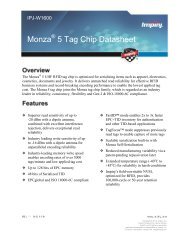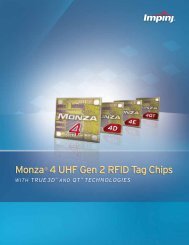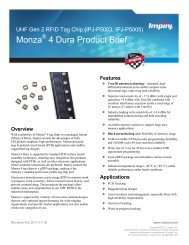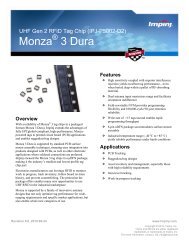Indy R1000 Datasheet - Impinj
Indy R1000 Datasheet - Impinj
Indy R1000 Datasheet - Impinj
You also want an ePaper? Increase the reach of your titles
YUMPU automatically turns print PDFs into web optimized ePapers that Google loves.
<strong>Indy</strong> <strong>R1000</strong> ® Electrical, Mechanical, & Thermal Specification<br />
5.4 Antenna Configuration Scenarios<br />
There are two different use scenarios for the <strong>Indy</strong> <strong>R1000</strong> reader chip based on the antenna subsystem. The first one involves a single antenna<br />
configuration as shown in Figure 9. In this application, a circulator is used to isolate the transmit and receive paths. Although the figure illustrates the<br />
more general case where two (or more) physically separated antennas are controlled by a switch, each antenna performs the RX and TX function.<br />
The antenna reflection of CW transmit power in receive mode dominates the receiver compression point requirement. With a maximum transmit<br />
power at the antenna port of +30 dBm and assuming an antenna reflection loss of 15 dB, an in-band blocker of +15 dBm must be tolerated at the<br />
receiver input. In this configuration, an external pad is connected at the Rx_in port to avoid compression of the LNA. A high impedance tap at the<br />
output of the PA is implemented to generate the LO_in signal used to drive the RX mixers.<br />
Tx / Rx _ 2<br />
Tx / Rx _ 1<br />
Band select<br />
Filter<br />
Figure 9: Single Antenna Scenario<br />
Rx _ in<br />
PA _ out<br />
LO _ in<br />
A second scenario allows separate antenna connections for receive and transmit as shown in Figure 10. The figure illustrates the more general case<br />
where two (or more) physically separated antennas are controlled by a switch, with each antenna only performing the RX or TX function. The<br />
isolation between the receive and transmit antennas is 25–30 dB; therefore, the in-band blocker caused by the CW transmit signal is in the order of<br />
+0 dBm. This scenario significantly reduces the compression requirements on the receiver and allows for a more sensitive receiver. A high<br />
impedance tap at the output of the PA is implemented to generate the LO_in signal used to drive the RX mixers.<br />
Figure 10: Dual Antenna Scenario<br />
22 Revision 2.3, Copyright © 2012, <strong>Impinj</strong>, Inc.







